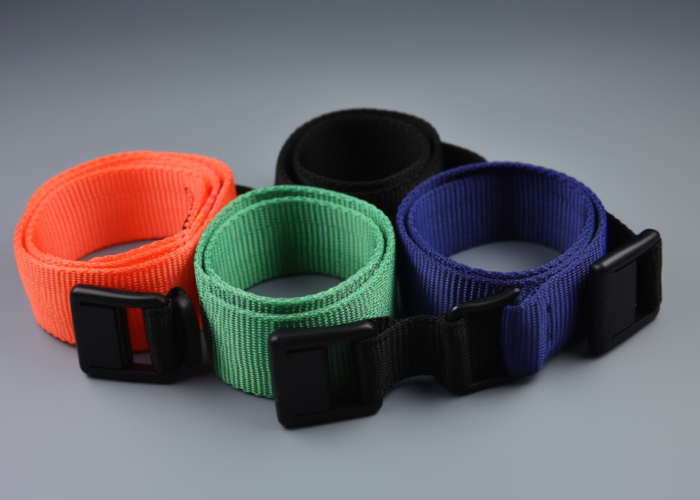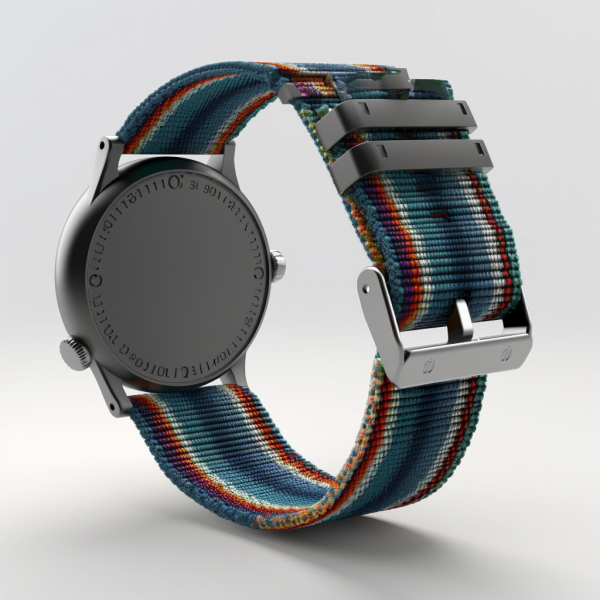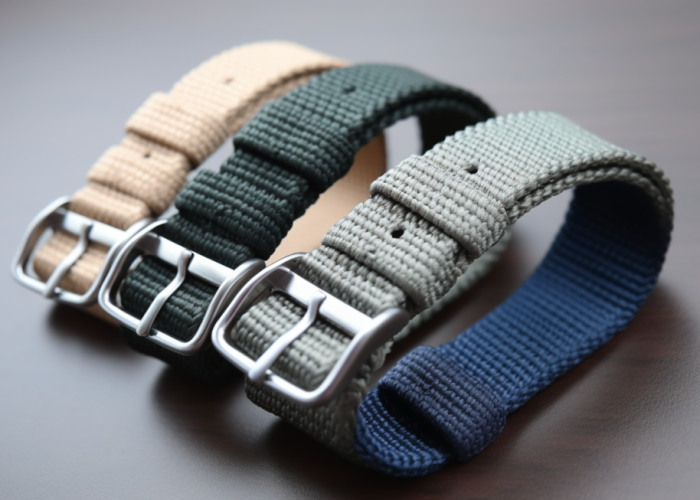Selecting the right webbing material for watch bands requires balancing technical specifications with aesthetic requirements. As custom webbing manufacturers with extensive experience serving watch brand designers and product developers, we’ve tested and produced various webbing types that deliver optimal performance across different watch band applications.
Nylon, polyester, polypropylene, elastic, and jacquard webbing are the main types used for watch bands. Each offers specific benefits in durability, stretch, water resistance, or design, depending on the application.
Explore the technical properties of webbing materials for watch bands, with examples and expert guidance to help you choose the best option for your design and performance needs.


Webbing manufacturing expert with 15+ years of experience helping product developers build high-performance straps for industrial, medical, and outdoor use.
The most common types of watch band webbing materials include nylon webbing, polyester webbing, polypropylene webbing, elastic webbing, and jacquard webbing. Each type offers distinct performance characteristics that make it suitable for specific watch band applications, with material selection depending on factors like durability requirements, aesthetic preferences, and intended use environment.
Nylon and polyester dominate the performance watch band market due to their durability and versatility. While similar in appearance, they differ significantly in moisture absorption, UV resistance, and temperature performance.
Specialty materials like polypropylene provide solutions for specific challenges such as chemical exposure or lightweight requirements. Elastic webbing offers comfort-focused applications where flexibility is essential. For premium watch bands, jacquard webbing provides sophisticated aesthetic options through complex patterns.
The selection process balances technical requirements with cost considerations. Entry-level watch bands typically utilize basic polyester or polypropylene, while premium collections employ specialized nylon formulations or custom jacquard patterns that deliver superior performance and brand distinction.
Nylon webbing offers five key properties for watch bands: exceptional tensile strength of 7,500-9,000 psi, moderate moisture absorption (4-7%) for skin comfort, excellent abrasion resistance, good UV resistance when treated, and a soft hand feel with natural flexibility that conforms to wrist contours.
The molecular structure of nylon creates its distinctive performance profile. The polyamide polymer chains form hydrogen bonds that contribute to its remarkable tensile strength while maintaining flexibility, making it suitable for high-performance watch bands.
In outdoor applications, nylon’s natural UV resistance can be enhanced through specialized treatments. Standard nylon loses approximately 4-7% strength per year of regular exposure, but with proper UV inhibitors, this degradation can be reduced to less than 1% annually.
Temperature performance represents another advantage of nylon webbing. The material maintains flexibility in cold environments down to approximately -40°F while retaining structural integrity in heat up to 180°F. This wide operational range ensures consistent performance across diverse wearing conditions.

Polyester webbing performs exceptionally well for watch band applications due to its superior UV resistance (2-3% strength loss annually vs. 4-7% for untreated nylon), minimal moisture absorption (0.4% vs. 4% for nylon), excellent color retention, and dimensional stability. These properties make polyester ideal for outdoor use watch bands requiring consistent performance in variable conditions.
The molecular composition of polyester creates its distinctive moisture-resistant properties. Unlike nylon’s polyamide structure, polyester’s ester bonds resist water penetration, resulting in faster drying times and reduced weight fluctuation when wet.
Color performance represents a significant advantage for polyester in fashion-oriented watch bands. The material accepts and retains dyes more effectively than nylon, allowing for vibrant, long-lasting colors that maintain appearance even after repeated exposure to sunlight and chemicals.
The manufacturing process for polyester webbing can be optimized to enhance specific performance attributes. Tighter weave patterns increase abrasion resistance while specialized heat-setting techniques improve dimensional stability, allowing designers to fine-tune properties for precise requirements.
Polypropylene webbing should be used for watch bands when chemical resistance, lightweight properties (specific gravity of 0.91 compared to nylon’s 1.14), quick-drying capability, and cost-effectiveness are primary concerns. This material is ideal for water-sport watch bands, swimming applications, and budget-conscious designs.
The chemical structure of polypropylene creates its distinctive resistance profile. As a hydrocarbon polymer without ester or amide bonds, polypropylene resists degradation from most acids, alkalis, and organic solvents, making it valuable for industrial environments or pools with high chlorine content.
Weight considerations make polypropylene excellent for performance-oriented applications. With a specific gravity approximately 20% lower than nylon and 30% lower than polyester, polypropylene creates noticeably lighter watch bands, improving comfort during dynamic activities.
The primary limitation is its lower melting point (approximately 320°F compared to nylon’s 490°F), making it less suitable for high-heat exposure. Additionally, without specialized treatments, polypropylene offers lower UV resistance than polyester, making UV-stabilized formulations essential for outdoor applications.
Elastic webbing is ideal for certain watch band designs because it provides 60-120% elongation capability, body-conforming comfort, tension adjustment without buckles or clasps, reduced pressure points around the wrist, and weight distribution that prevents watch movement during activity. These properties make elastic webbing perfect for athletic, medical, and comfort-focused watch bands.
The structural design incorporates specialized rubber or spandex fibers that enable controlled stretch and recovery. Premium elastic webbing maintains consistent tension through thousands of stretch cycles without permanent deformation, ensuring bands maintain fit throughout extended use.
Manufacturing variations create distinct performance profiles. Woven elastic incorporates rubber or spandex threads within a traditional weave pattern, providing moderate stretch (typically 60-80%) with excellent recovery. Braided elastic constructions offer greater stretch capacity (often 100-120%) but may demonstrate more pronounced tension loss over time.
Recent innovations have addressed traditional limitations. Advanced polymer formulations improve UV resistance and moisture management, while specialized coatings enhance abrasion resistance at high-friction contact points, expanding applications beyond comfort-focused designs to include performance sport bands.

Jacquard webbing should be chosen for premium watch bands because it enables complex pattern integration directly into the material structure, provides brand identity reinforcement through customized designs, delivers superior aesthetic quality with precise detail reproduction, maintains pattern integrity even after extended wear, and commands higher perceived value than printed alternatives.
The jacquard manufacturing process employs specialized looms that individually control hundreds of warp threads to create intricate patterns. Unlike printed webbing, jacquard patterns are structurally integrated throughout the material, ensuring patterns remain visible even as surface fibers experience wear.
Brand identity expression represents a primary advantage. Custom patterns can incorporate logos, trademark elements, and brand-specific design motifs that reinforce visual identity. With resolution capabilities of approximately 20-30 threads per inch, jacquard webbing can reproduce detailed designs that enhance brand recognition.
Despite aesthetic advantages, jacquard webbing maintains performance characteristics comparable to standard webbing of similar material composition, allowing designers to incorporate sophisticated visual elements without compromising functional performance.
High-quality watch band webbing is ensured through five key manufacturing techniques: precision tension control during weaving that maintains consistent density, heat-setting processes that stabilize dimensions, specialized edge treatments that prevent fraying, advanced dyeing methods that improve colorfastness, and rigorous quality testing of physical properties.
Weaving tension represents a critical quality factor. Inconsistent tension creates variation in material density, leading to uneven performance. Advanced looms employing electronic tension monitoring maintain precision within ±0.5% throughout production runs, ensuring uniform strength across the entire length.
Thermal processing significantly impacts performance characteristics. Controlled heat-setting permanently stabilizes the molecular structure of synthetic fibers, reducing potential shrinkage to less than 1% even after repeated exposure to moisture and temperature fluctuations.
Edge treatment technologies prevent fraying and unraveling. Advanced techniques include ultrasonic cutting that simultaneously seals edges, specialized polymer edge coatings that encapsulate exposed fibers, and micro-folded edge constructions that eliminate exposed ends entirely.

Patterns and logos can be applied to watch band webbing through five primary methods: jacquard weaving that integrates designs directly into the material structure, dye sublimation printing for vibrant full-color images, screen printing for solid color designs, heat transfer application for photorealistic reproduction, and embroidery for textured dimensional effects.
Each application method offers distinct advantages. Jacquard weaving provides exceptional durability with patterns that cannot wear off but requires minimum production quantities. Dye sublimation creates permanent molecular bonds between dyes and synthetic fibers, allowing for photorealistic images with excellent wash fastness.
Screen printing offers cost-effective customization for smaller production runs, with modern formulations achieving wash-fastness ratings of 4-5 on the standard 5-point scale when properly cured, though they may show gradual wear at flex points over extended use.
Heat transfer technology bridges the gap between production flexibility and image quality. Computer-controlled systems precisely apply thin polymer films containing printed designs to webbing surfaces, achieving bond strength of 25-30 psi, sufficient to withstand flexing and abrasion typical in watch band applications.
Selecting the right webbing material for watch bands involves balancing technical properties with aesthetic requirements. From nylon’s strength and polyester’s UV resistance to polypropylene’s lightweight properties, elastic’s comfort, and jacquard’s premium appearance, each material serves specific applications. Understanding manufacturing techniques and customization options enables optimal material selection for your specific watch band design needs.
Watch band webbing longevity requires material-specific care protocols. Nylon and polyester bands should be hand-washed in mild soap, air-dried away from direct sunlight, and stored in cool, dry environments. Avoid harsh chemicals, prolonged UV exposure, and high heat. Elastic webbing benefits from periodic stretching to maintain tension properties, while jacquard patterns require gentle cleaning to preserve design integrity.
Yes, eco-friendly watch band webbing options include recycled PET polyester (made from post-consumer plastic bottles), organic cotton blends, and hemp-based composites. These materials offer 15-20% reduced carbon footprint compared to virgin synthetics while maintaining comparable performance specifications. Recycled polyester retains 90-95% of virgin material strength while consuming 30-50% less energy during production.
Watch band webbing customization options include over 180 standard colors with custom color matching available (±0.5 ΔE on the CIELab scale), jacquard patterns with up to 30 threads per inch resolution, multiple logo application methods (weaving, printing, heat transfer), specialty finishes (water-repellent, antimicrobial, reflective), and custom edge treatments for improved durability and distinctive brand aesthetics.
Choose the right watch band webbing by evaluating five key factors: performance requirements (tensile strength, UV resistance), comfort considerations (flexibility, moisture management), aesthetic needs (color options, pattern capabilities), environmental exposure (water, chemicals, temperature), and price targets. Submit detailed specifications to receive material samples with comparable properties before making final production decisions.
Temperature significantly impacts webbing performance. Nylon maintains flexibility to -40°F but absorbs moisture when humid. Polyester offers stability from -20°F to 220°F with minimal property changes. Polypropylene becomes brittle below 15°F and softens near 160°F. Elastic webbing experiences 10-15% tension reduction in cold and accelerated aging in heat. Always consider your product’s operating temperature range when selecting materials.
Watch band webbing is commonly available in widths from 16mm to 24mm, with standard increments of 2mm. Thickness typically ranges from 1.2mm to 2.5mm depending on application requirements. Custom widths and thicknesses can be manufactured for specific product designs, with minimum order quantities starting at 1,000 meters for standard materials and 2,500 meters for custom specifications.